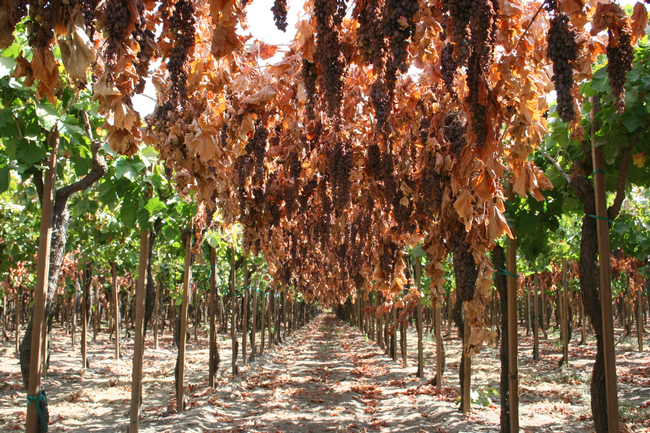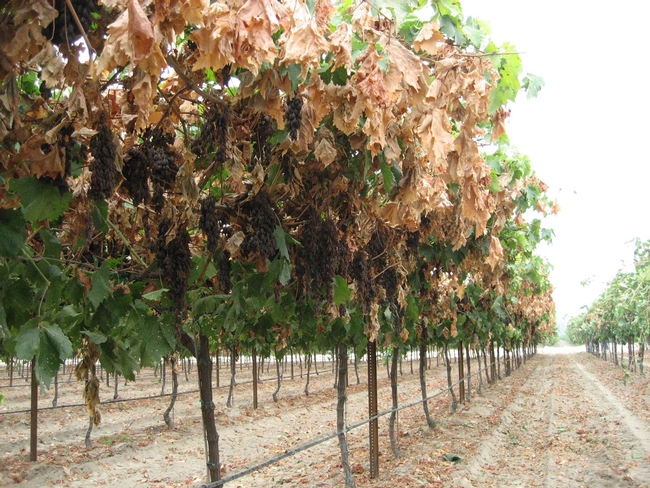Posts Tagged: raisins
UC releases new cost studies for growing plums and raisins in the San Joaquin Valley
UC Agricultural Issues Center has released three new studies, one on the cost and returns of establishing an orchard and producing fresh market plums, and the cost and returns of establishment and production of dried-on-vine (DOV) raisins under two different trellis systems.
The cost and returns are multi-year studies based on hypothetical farm operations of well-managed orchards and vineyards, using practices common to the San Joaquin Valley. Growers, UC ANR Cooperative Extension farm advisors and other agricultural associates provided input and reviewed the methods and findings of the studies.
The plum study, using double-line drip irrigation, estimates costs from orchard establishment through the production years. The economic life of the orchard used in this cost analysis is 18 years.
The DOV raisin establishment and production cost studies are under different trellis systems; overhead trellis system (OHTS) and open gable trellis system (OGTS). The two separate DOV raisin studies use single-line drip irrigation. The economic life of the vineyards used in these cost analysis is 30 years.
The authors describe the assumptions used to identify current costs for each crop, material inputs, cash and non-cash overhead. A ranging analysis table shows net returns over a range of prices and yields. Other tables show the monthly cash costs, the costs and returns per acre, hourly equipment costs, and the whole farm annual equipment, investment and business overhead costs.
The new studies are titled:
- Sample Costs to Establish an Orchard and Produce Fresh Market Plums in the San Joaquin Valley – South- 2016
- Sample Costs to Establish a Vineyard and Produce DOV Raisins (OGTS) in the San Joaquin Valley - 2016
- Sample Costs to Establish a Vineyard and Produce DOV Raisins (OHTS) in the San Joaquin Valley - 2016
Free copies of these studies and other sample cost of production studies for many commodities are available online. To download the cost studies, visit the UC Agricultural Issues Center Cost Studies website at http://coststudies.ucdavis.edu.
The cost and returns program is funded by the UC Agricultural Issues Center, which is part of UC Division of Agriculture and Natural Resources, and the UC Davis Department of Agricultural and Resource Economics.
For additional information or an explanation of the calculations used in the studies, contact Donald Stewart through the UC Agricultural Issues Center at (530) 752-4651 or destewart@ucdavis.edu. Contact UC Cooperative Extension advisors through the local UCCE office http://ucanr.edu/County_Offices
Raisins are the focus of the 2014 San Joaquin Valley Grape Symposium
Over the last 10 years, Fresno County farmers have reported increasing raisin moth populations in organic raisin vineyards. Addressing this concern, Kent Daane, UC Cooperative Extension specialist in the Department of Environmental Science, Policy and Management at UC Berkeley, will update growers on the pest’s biology, management and damage at the San Joaquin Valley Grape Symposium Jan. 8 in Easton.
Daane and his research associates followed moth populations in organic and conventional fields to document this observed change and determine if there were any specific causes for increases in raisin moth densities. In a 2013 season study, UC Kearney Agricultural Research and Extension Center entomologists found that spring to early summer pheromone trap catches of raisin moths were prevalent across numerous vineyards, regardless of management practices. However, overall seasonal damage in 2013 was low.
“The primary difference between vineyard sites with or without raisin moth damage appeared to be well-timed and effective insecticide sprays,” Daane said. “One problem for organic sites may be the availability of insecticide materials that have long enough residual activity to control the larvae of adult moths entering the vineyard, and once the larvae are deep inside the grape cluster they are difficult to control.”
In addition to Daane’s report, the San Joaquin Valley Grape Symposium includes the following research updates:
- Rootstocks for raisin production by Sonet Von Zyl, Fresno State University
- Raisin production canopy management by Matthew Fidelibus, UC Cooperative Extension specialist in the Department of Viticulture and Enology at UC Davis, based at the UC Kearney Ag REC in Parlier
- Raisin grape breeding program by Craig Ledbetter, USDA Agricultural Research Service, based in Parlier
- Economics of producing raisins, by Annette Levi, Fresno State University
- Grapevine trunk diseases and grower survey
The symposium begins with registration at 7 a.m. and concludes following lunch at 1 p.m. at the C.P.D.E.S. Hall, 172 W. Jefferson Ave., Easton, Calif.
Registration is $15 in advance and includes lunch. Registration at the door is $20. To preregister, send the names of attendees and a check payable to UC Regents for $15 each to San Joaquin Valley Grape Symposium, 550 E. Shaw Ave., Suite 210-B, Fresno, CA 93710. To register with a credit card, fill out the online registration form at http://ucanr.edu/sjv2014.
UC scientists see ravages of new pest firsthand
A group of UC scientists traveled to Chile recently to see firsthand vineyard damage caused by the European grapevine moth, according to an article in the Fresno Bee. The moth has been detected in California's Napa County, and is being actively tracked in the valley to determine whether the infestation has spread.
European grapevine moth was discovered three years ago in Chile. Because the pest develops from larvae to moth at a crucial time in the grape's growth cycle, its effects can be devastating.
"They have lost whole vineyards in Chile; not one grape was picked," UC entomologist Walt Bentley was quoted in the Bee. "It actually lays its eggs on the berry, and as the berries bloom little flower clusters, the larvae begins feeding on that. It is a voracious eater."
Napa County is world-renowned for its fine wines, but it may be the San Joaquin Valley that has the larger stake in the effort to keep the European grapevine moth at bay. Valley farmers produce nearly all of California's table and raisin grapes and, with 1.3 million tons of grapes for crush in 2009, lead the state's production of grapes for wine and concentrate.
A major European grapevine moth infestation could cost the industry millions of dollars in control efforts and lost sales to countries that block imports from areas with the pest, wrote Bee reporter Robert Rodriguez.
More information on the European grapevine moth is available on the UC Integrated Pest Management Web site.

European grapevine moth



